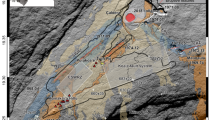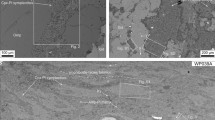Abstract
Well data and core samples from the Late Paleozoic Halle Volcanic Complex (HVC) have been used to describe the geometry of the rhyolitic porphyritic laccoliths and their margins. The HVC formed between 301 and 292 Ma in the intramontane Saale basin, and it comprises mainly rhyolitic subvolcanic bodies (~300 km3) as well as minor lava flows and volcaniclastic deposits. The major HVC laccolith units display aspect ratios ranging between 0.04 and 0.07, and they are separated by tilted and deformed Carboniferous–Permian host sediments. For the margin of the Landsberg laccolith, a major coarsely porphyritic unit of the HVC, an exceptional data set of 63 wells concentrated in an area of 10 km2 reaching to depth of 710 m exists. It was used to explore the 3D geometry and textures, and to deduce an intrusion model. For a 3D visualization of the Landsberg laccolith margin, Geological Object Computer Aided Design; Paradigm® software (GOCAD) was used. Curve objects have been derived from the intrusion–host contacts. Automated GOCAD® methods for 3D modelling failed. As a result, manual refinement was essential. A major finding of the 3D modelling is the presence of prolate sediment rafts, up to 1,400 m in length and up to 500 m in thickness, surrounded by Landsberg rhyolite. The sedimentary rafts dip away from the laccolith centre. The engulfing laccolith sheets reach thickness of 100–300 m. For other HVC laccolith units (Löbejün, Petersberg, Brachstedt), well data reveal vertical rhyolite/sediment contacts or magma lobes fingering into the host sediments. HVC laccolith contact textures include small-scale shearing of the intruding magma and of the host sediment. In addition, internal shear zones have been detected inside the rhyolite bodies. The present study suggests that the emplacement of successive magma sheets was an important process during laccolith growth in the HVC.






Similar content being viewed by others
Notes
GOCAD® technical terms given in italics.
References
Awdankiewicz M, Breitkreuz C, Ehling B-C (2004) Emplacement textures in Late Palaeozoic andesite sills of the Flechtingen–Roßlau Block, north of Magdeburg (Germany). Geol Soc Spec Publ 234:5–12
Breitkreuz C, Mock A (2004) Are laccolith complexes characteristic of transtensional basin systems? Examples from Permocarboniferous Central Europe. Geol Soc Spec Publ 234:13–32
Breitkreuz C, Ehling B-C, Sergeev S (2009) Chronological evolution of an intrusive/extrusive system: the Late Paleozoic Halle Volcanic Complex in the north–eastern Saale Basin (Germany). Zeitschr dt Gesell Geowiss 160:173–190
Breitkreuz C, Ehling B-C, Pastrick N (accepted) The subvolcanic units of the Late Paleozoic Halle Volcanic Complex, Germany: geometry, internal textures and emplacement mode. In: Breitkreuz C, Rocchi S (eds) Physical geology of high-level magmatic systems. Advances in volcanology 2. Springer, Berlin
Bunger AP, Cruden AR (2011) Modeling the growth of laccoliths and large mafic sills: role of magma body forces. J Geophys Res 116:B02203
Corry CE (1988) Laccoliths; mechanics of emplacement and growth. Spec Pap Geol Soc Am 220:1–110
Cross CW (1894) The laccolithic mountain groups of Colorado, Utah and Arizona. In: US geological survey, 14th annual report, vol 2, pp 157–241
Cruden AR, McCaffrey KJW (2001) Growth of plutons by floor subsidence: implications for rates of emplacement, intrusion spacing and melt-extraction mechanisms. Phys Chem Earth (A) 26:303–315
de Saint Blanquat M, Habert G, Horsman E, Morgan SS, Tikoff B, Launeau P, Gleizes G (2006) Mechanisms and duration of nontectonically assisted magma emplacement in the upper crust: The Black Mesa pluton, Henry Mountains, Utah. Tectonophysics 428:1–31
Ehling B-C, Gebhardt U (2012) Rotliegend im Saale-Becken. Schriftenr Deutsch Gesell Geowiss H 61:504–516
Gebhardt U, Lützner H (2012) Innervariscische Rotliegendbecken und Norddeutsches Becken—Fragen ihrer stratigraphischen Verknüpfung. Schriftenr Deutsch Ges Geowiss H 61:715–730
Gilbert GK (1877) Geology of the Henry Mountains, Utah. US geographical and geological survey of the rocky mountain region, Government Printing Office, Washington, DC, pp 1–196
Horsman E, Morgan SS, de Saint Blanquat M, Habert G, Nugent A, Hunter RA, Tikoff B (2009) Emplacement and assembly of shallow intrusions from multiple magma pulses, Henry Mountains, Utah. Earth Environ Sci Trans R Soc Edinb 100:117–132
Hoth K, Rusbült J, Zagora K, Beer H, Hartmann O (1993) Die tiefen Bohrungen im Zentralabschnitt der Mitteleuropäischen Senke—Dokumentation für den Zeitabschnitt 1962–1990. Schriftenr Geowiss 2:7–145
Hutton DHW (2009) Insights into magmatism in volcanic margins: bridge structures and new mechanism of basic sill emplacement—Theron Mountains, Antarctica. Geol Soc Lond Pet Geosci 15:269–278
Kampe A, Luge J, Schwab M (1965) Die Lagerungsverhältnisse in der nördlichen Umrandung des Löbejüner Porphyrs bei Halle (Saale). Geologie 14:26–46
Knoth W, Kriebel U, Radzinski K-H, Thomae M (1998) Die geologischen Verhältnisse von Halle und Umgebung. Hall Jb Geowiss Beiheft 4:7–34
Kokelaar BP (1982) Fluidization of wet sediments during the emplacement and cooling of various igneous bodies. Geol Soc Lond 139:21–33
Lorenz V, Haneke J (2004) Relationship between diatremes, dykes, sills, laccoliths, intrusive extrusive domes, lava flows, and tephra deposits with unconsolidated water-saturated sediments in the late Variscan intermontane Saar-Nahe Basin, SW Germany. Geol Soc Lond Spec Publ 234:75–124
Mallet JL (1989) Discrete smooth interpolation in geometric modeling. ACM Trans Graph 8(2):121–144
Mock A, Breitkreuz C (2006) Parameters controlling emplacement of shallow-level silicic intrusions—an exploratory study in a Late Paleozoic laccolith complex. Vis Geosci 11:47–48
Mock A, Jerram DA, Breitkreuz C (2003) Using quantitative textural analysis to understand the emplacement of shallow-level rhyolitic laccoliths—a case study from the Halle Volcanic Complex, Germany. J Petrol 44:833–849
Mock A, Ehling B-C, Breitkreuz C (2005) Anatomy of a laccolith complex—geometry and texture of porphyritic rhyolites in the Permocarboniferous Halle Volcanic Complex (Germany). N Jb Geol Paläont Abh 237:211–271
Morgan SS, Stanik A, Horsman E, Tikoff B, de Saint Blanquat M, Habert G (2008) Emplacement of multiple magma sheets and wall rock deformation: trachyte Mesa intrusion, Henry Mountains, Utah. J Struct Geol 30:491–512
Pollard DD, Johnson AM (1973) Mechanics of growth of some laccolithic intrusions in the Henry mountains, Utah, II: bending and failure of overburden layers and sill formation. Tectonophysics 18(3–4):311–354
Pollard DD, Muller OH, Dockstader DR (1975) The form and growth of fingered sheet intrusions. Bull Geol Soc Am 86:351–363
Rocchi S, Westerman DS, Dini A, Farina F (2010) Intrusive sheets and sheeted intrusions at Elba Island (Italy). Geosphere 6:225–236
Romer R, Förster H-J, Breitkreuz C (2001) Intracontinental extensional magmatism with a subduction fingerprint: the late Carboniferous Halle Volcanic Complex (Germany). Contrib Min Petrol 141:201–221
Schulz N (2010) Dreidimensionale geologische Modellierung eines spätpaläozoischen inter-mediären subvulkanischen Komplexes nördlich von Halle (Saale). Unpubl. diplom. thesis, TU Bergakademie Freiberg, Germany
Schwab M (1959) Zur Deutung des Quarzporphyrs vom Kahlbusch bei Dohna (Sachsen) als Quellkuppe. Geol Rundsch 48:43–54
Siegert C (1967) Die zeitliche und räumliche Entwicklung des intermediären Vulkanismus im Halleschen Permokarbonkomplex. Geologie 16:889–900
Thomson K, Schofield N (2008) Lithological and structural controls on the emplacement and morphology of sills in sedimentary basins. Geol Soc Lond Spec Publ 302:31–44
Acknowledgments
We thank the WISMUT GmbH for permitting access to and sampling of wells. We are also grateful to Jan Bergemann who helped creating the movie (ESM Appendix).
Author information
Authors and Affiliations
Corresponding author
Electronic supplementary material
Below is the link to the electronic supplementary material.
Supplementary material 1 (AVI 18265 kb)
Rights and permissions
About this article
Cite this article
Schmiedel, T., Breitkreuz, C., Görz, I. et al. Geometry of laccolith margins: 2D and 3D models of the Late Paleozoic Halle Volcanic Complex (Germany). Int J Earth Sci (Geol Rundsch) 104, 323–333 (2015). https://doi.org/10.1007/s00531-014-1085-7
Received:
Accepted:
Published:
Issue Date:
DOI: https://doi.org/10.1007/s00531-014-1085-7




